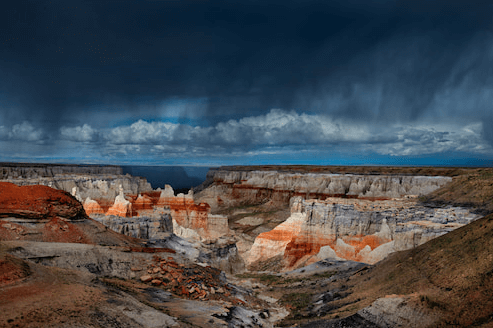What do you think of when you hear the words “Native American”?
There isn’t a singular Native American identity — the US alone has 574 federally recognized tribes, as well as hundreds more unrecognized ones, each with their own history, culture, and in many cases, language. Did you know that more than 260 indigenous languages are spoken in the United States and Canada?
Why Learn an Indigenous Language?
You should consider learning an indigenous language if:
You want a challenge. Unlike Romance and Germanic languages, indigenous languages do not share direct roots with English. This means that the vocabulary and grammar will be completely new — and the linguistic diversity completely fascinating.
You want to set yourself apart in the job market. Everyone is learning European languages like Spanish, French, or even Arabic or Chinese. Don’t you want to stand out?
You want to work with a local community. Maybe Standing Rock has woken you up to environmental racism, or maybe you’re outraged by the poor living conditions on some reservations. If you want to work or do research with an indigenous community, speak to a member about learning their language.
You’re an indigenous person who wants to reclaim your language. Many indigenous languages were all but wiped out when the US government opened boarding schools in 1860. These schools effectively kidnapped children from their communities and stripped them of their language and culture. Today, reclaiming the language is an act of resistance.
You’re just interested. If you have a passion for a language, then go for it! That’s a good enough reason.
So, which languages should you learn? We have a few suggestions.

Language: Cherokee
Other names: Tsalagi
Tribe: Cherokee
Region: North Carolina, Oklahoma, Arkansas
Number of speakers: 12,000
Size of tribe: 316,000
Distinctive features:
- More literature has been written in Cherokee than in any other Native American language. This literature includes dictionaries, Bible passages and a newspaper dating back to the 19th century.
- Cherokee has its own syllabary, developed by Sequoyah (George Gist) in 1821. Before he created the syllabary, he was illiterate.
- Cherokee often uses one word to express entire sentences. One word can contain the action, the object, the subject, the context and the location — all in just a few syllables! This is called a polysynthetic language.
- Cherokee has six tones (high, high fall, rising, low, low fall, falling), although younger speakers are radically simplifying the tones to make it easier to learn. One day, they may disappear altogether.
Resources: Take language classes online at the official Cherokee website.
Language: Navajo
Other names: Diné
Tribe: Navajo
Region: Arizona, Utah, New Mexico, Colorado
Number of speakers: 169,000
Size of tribe: 300,000 members
Distinctive features:
- This is the most spoken Native American language in the US.
- Navajo has four tones (high, rising, falling, low), marked by accents.
- Navajo has a slow speech tempo; in other words, it is spoken more slowly than English.
- In 1939, Navajo speakers tried to create and implement an alphabet, but it never caught on.
- In 1977, Star Wars was translated into Navajo, becoming the first major motion picture to be translated into a Native American language!
Resources: Check out the Beginner Navajo app, or learn it one word at a time at Navajo Word of the Day.

Language: Central Alaskan Yup’ik
Other names: West Alaska Yup’ik
Tribe: Yup’ik
Region: Alaska, Canada, Siberia
Number of speakers: 10,400
Size of tribe: 34,000 members
Distinctive features:
- Four different types of Yupik are spoken in Alaska: Central Alaskan Yup’ik (10,400 speakers), Central Siberian Yupik (1,200 speakers), Alutiiq (500 speakers), and Naukan Yupik (60 speakers).
- A fifth dialect of Yupik, Serenik, went extinct in 1997.
- Although these languages all stem from the same proto-language, they are unintelligible to each other; it’s like the difference between Spanish and French.
- Like Cherokee, Central Alaskan Yup’ik builds out from verbs, so a single word can encapsulate an entire sentence. For example: Tuntussuqatarniksaitengqiggtuq means “She/he said again that she/he was not hunting caribou.”
Resources: Pick up the basics at Alaskool, or commit to a degree at the Alaska Native Language Center.
Language: Choctaw
Other names: Chahta’
Tribe: Choctaw
Region: Oklahoma, Mississippi, Louisiana, Tennessee
Number of speakers: 10,400
Size of tribe: 300,000 members
Distinctive features:
- Choctaw is very closely related to Chickasaw (spoken by 75 people), and some people consider the latter a dialect of the former.
- The word “Oklahoma” comes from Choctaw; it means “red people.”
- Choctaw has three different alphabets: Byington, Swanton and Modern. Most Choctaw speakers use a variation of Modern, indicating long vowels by doubling them.
- Choctaw has three dialects.
Resources: Start learning for free at the School of Choctaw Language.
Language: Washo
Other names: Washoe
Tribe: Washo
Region: California-Nevada border
Number of speakers: 20
Size of tribe: 1,500 members
Distinctive features:
- An immersion school began in 1994 to try to revive the language. It closed, but many of its former students are now teachers carrying the mantle.
- Washo is a language isolate — that means it has no direct link to any other language! It’s not even related to the languages geographically surrounding it.
- Because the speaking population is so small, there are no regional differences in dialect.
- Washo borrows many words from English, such as k’indí (candy).
- Washo uses “ʔ” as a letter, but it’s not a question mark! It’s a glottal stop, which sounds like the space between the vowel sounds in “uh-oh.”
Resources: Jump in at the official Washo website!

Learning a Native American Language
Learning a Native American language might not have been at the top of your list, but with more than 250 languages, the possibilities are endless. Whether you want to connect with a local community or study fascinating systems of writing, consider looking at an indigenous language.
Nizhónígo ch’aanidíínaał!
That means “have a good journey” in Navajo!